SSEF FACETTE No. 12
GEMMOLOGIE
No. 12,
2005
allowed with reference to the Swiss Gemmological Institute SSEF
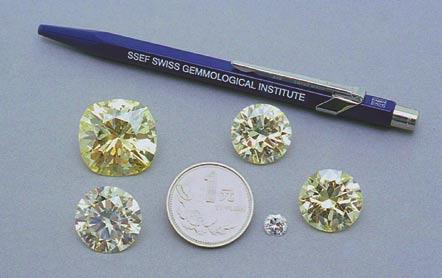
In this Issue: - Diamonds are forever
- New Diamond Courses 2005
- Coral en Vogue
- LIBS in Gemmology
- Lead glass in Ruby
- New: Launching of SSEF Alumni
- News from CIBJO and LMHC
- GemmoBasel 2005
SSEF Facette No. 12, © 2005
SWISS GEMMOLOGICAL INSTITUTE SCHWEIZERISCHES GEMMOLOGISCHES INSTITUT INSTITUT SUISSE DE
International Issue
January
Reproduction
Dear Reader
The year 2004 was again packed with many inter esting challenges for the SSEF laboratory but also for the trade. We are lucky that business for the SSEF was much better than predicted under tight general conditions. The high performance and the degree of integrity of the SSEF is appreciated by a number of well-known international companies. We notice with pleasure that our origin determinations and treatment identifications form an important part of our activity and strongly influence the price of a gem. Reliable SSEF Test Reports for pearls guarantee the trade with sometimes extremely rare items, such as the 2-strand necklace of beautiful white natural pearls that fetched 3.2 million Swiss Francs in a recent auction.
pearl research in China, instrumental development in Florida, diamond conference in England, SSEF is always on the edge. And you may profit from this: SSEF is proud to have found a new analyti cal solution for the detection of beryllium diffusion treated sapphires, which caused so much concern and “headache” to the international gem trade. The SSEF is the first laboratory offering an inexpensive and reliable Be detection service.
We are glad to offer you the SSEF Facette in a new and colourful look. We are continuing to produce this newsletter in three languages: German, French and English.
Finally, I would like to express our best wishes for a healthy, lucky and prosperous year 2005
Henry A. Hänni, Director of SSEF Swiss Gemmological Institute

At the end of April 2005, an important gemmological event will take place in Basel: Gemmo Basel2005. A first class selection of speakers will deliver talks on actual topics across the gem industry. We expect about 150 participants at this unique conference, who will enjoy the presenta tions as well as the social activities. During GemmoBasel2005 we are launching our SSEF Alumni Association, a club for former SSEF students. SSEF Alumnis will participate in a net work of gemmological, business and information links. SSEF Education was again doing very well in 2004. Courses on various levels have taken place and a number of students began, continued or finished their gemmological education. Some companies from the watch industry but also from the high-end jewellery sector are aware of SSEF’s capacity and take profit by selecting measure tailored courses.
The well-welded team of SSEF will have to let go Dr. Lore Kiefert, our present director for coloured stones. Dr. Kiefert is heading to New York, where she will take a leading position in the AGTA gem lab. We have now found a suitable and promising person to replace Dr. Kiefert, and will report later about her.
SSEF research has produced a number of fine results. Having first hand information is crucial for a leading gemlab. In addition, members of the SSEF staff have travelled a lot in the past year in order to stay in a foremost position. Was it for
SSEF membership fee:
Dear SSEF Client
Did you already know that the SSEF Membership fee is due on February 28, and a reduction of ap prox. 20-30% on the normal tariff list is granted to registered members only ?
Impressum: Annual SSEF publication by: SSEF Swiss Gemmological Institute Falknerstrasse 9 CH-4051 Basel Switzerland
tel. +41-(0)61-262 06 40 fax. +41-(0)61-262 06 41 e-mail: gemlab@ssef.ch website: www.ssef.ch
Editorial Page 2 SSEF Facette No. 12, © 2005
Diamonds are forever
New challenges in the diamond trade:
Until today, the diamond market is characterized by traditions. Imagine going into the diamond bourse and you see thousands of carats being sold with one expression as the only guarantee: “Mazal”. With this, the deal is concluded. No written proof or contract is needed. “Mazal” is the insurance for an agreed price. In such a way each year thousands of stones change hands in all confidence. This is the Jewish tradition, as Mazal means good luck. Another tradition is the offering of a diamond to celebrate a happy event such as birth, engage ment, and marriage. A beautiful tradition, also for the diamond trade. It has stimulated the market for centuries and has made it become as powerful as it is nowadays. Behind that market is a profession that is respectful to its tradition.
Yet, this tradition has to withstand many new chal lenges, which have changed the diamond trade in the new millennium.
Just a few headlines:
- the so-called ‘war diamonds’ - the new marketing policy of DeBeers, - Canada suddenly being among the five largest producers of diamonds, - High Pressure/High Temperature (HPHT) treated diamonds, - the arrival of synthetic diamonds produced by CVD process, - synthetic diamonds said to be made from human ashes,
- a new ISO norm in diamond grading rejected by a majority of countries despite 17 years of hard work between CIBJO, GIA and HRD, - the grading of the cut as an additional factor to the traditional 4 C’s, - and last but not least, rumours spread during the last world diamond congress at Antwerp that synthetic diamonds wered mixed into batches of colourless small diamonds.
All these headlines are less than five years old. If somebody deliberately wanted to shake up the dia mond market, they couldn’t do any better. Despite these challenges from all sides, the diamond seems to resist as it is so persistent and hard.
How the trade faces these challenges:
All these headlines showed that there is a profes sional lobby around the diamond, and a trade animated by the passion of this mythical stone. Confronted with accusations from NGO’s (Non-
© H.A. Hänni, SSEF
Governmental Organisations) concerning ‘war diamonds’, the whole profession founded the World Diamond Council (WDC). This organisation was and still is supported by Eli Izhakoff, who is convinced of the positive direction of the mission. The WDC brought together the United Nations, governments, professionals and NGO’s to fight against misuse of the diamond trade and to implement international regulations for a controlled trade from mine to the end consumer. This effort lead to the so-called Kimberley process, and we hope that this regulation is further developing in a positive direction for the whole trade !
Recently, De Beers developed a new marketing strategy and at the same time Canada established itself among the most important diamond producing countries. Are these two isolated events or is there some connection? With a closer look, the connection between these events becomes evident. It start ed twenty years ago, when Australia first attacked De Beers’ dominant position in the diamond trade. Nowadays, with the rise of Canada as an important diamond producer, De Beers finally had to give up their position. It is thus not surprising that De Beers faces this challenge with a new marketing strategy. The group is wise enough to understand that doing nothing would mean loosing everything.
How the gemlabs face new challenges:
When testing a diamond, the main challenges for a laboratory are HPHT treatment, synthetic diamonds CVD, and colourless synthetic diamonds. All these topics are still producing some concern in the trade as it was the case already 20 years ago, but not for internationally reputed gemmological laboratories.

Focus Page 3SSEF Facette No. 12, © 2005
Remember, when the HPHT treated diamonds appeared on the market of colourless diamonds in 1999: „HPHT treated diamonds are undetectable!” said the company who treated these diamonds. But then the gemmological laboratories, the SSEF Swiss Gemmological Institute ahead, took the chal lenge and worked hard! Only one year later, they were able to identify HPHT treated diamonds with out any help of General Electric who shamelessly applied for a patent to protect not only the treatment but also the detection method. Similarily, concern ing CVD synthetic diamonds, the laboratories all showed that their identification is not too difficult.
of deceased human beings. To offer oneself a very expensive synthetic diamond to celebrate the death of a relative or close friend? Voilà, a concept as morbid as debatable…
Moreover, the rumours about small synthetic dia monds on the diamond market rather seem to be rumours than fact. In the last four years, SSEF has encouraged the Swiss watch and jewellery industry to certify the small diamonds they use for their products. A SSEF Test Report is offered to guarantee the authenticity of the small natural diamonds. Our reassuring conclusion: All the lots certified until now by SSEF were natural. The results presented on our SSEF Test Reports are based on scientific testing methods, i.e. X-ray radiography, UV-fluorescence and phosphorescence reactions. As you see, we are protecting the diamond – your market!
Since 1997, SSEF is equipped with the Diamond View®, loaned by DeBeers for identifying synthetic diamonds. With this instrument, we are also able to identify the synthetic diamonds from LifeGem (USA) and Algordanza (Switzerland). These synthetic diamonds are said to be produced from the ashes
The Gemological Institue of America (GIA) intends to grade the cut of brilliants. We wish them good luck! After all, the nomenclature established by Mr. Liddicoat fifty years ago has obviously proven that GIA has the capacity to do such a difficult job. Re garding the grading of the cut of stones, the SSEF will observe this issue together with other laboratories, especially in regard to our efforts for an inter national harmonisation.
To conclude, we state that the diamond market is in a stage of change. However, as a result of the many challenges, the market also shows its capability to resist and even to develop new strategies to flour ish. Diamonds are forever!
Why not learn more about diamonds: See our course programme 2005 for new diamond courses.
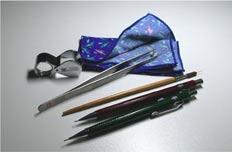
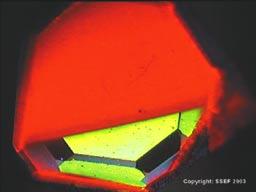
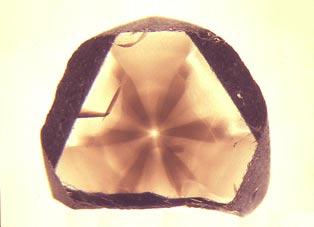
Focus Page 4 SSEF Facette No. 12, © 2005
This unusal floral pattern in a diamond is due to a hydro gen-enrichment in specific growth sectors (diamond by M. Alther). © H.A. Hänni, SSEF 2003
Fluorescence picture of a synthetic CVD diamond (red), grown upon a small “traditional” synthetic diamond seed crystal (yellow/black). The picture was taken with the DiamondView®. © SSEF 2004
New Diamond Courses in 2005
As last year, SSEF is offering again tremende ous possibilities for your gemmological formation in 2005. Apart from the annual basic (SSEF Basic Training) and advanced (SSEF Advanced Training and SSEF Scientific Training) courses, we will offer two new courses on diamond for the first time.
Basic Diamond Course
27 June – 1 July, 2005
One-week intense training on diamonds. The course is specially designed for sales staff and is focusing on the following topics: The formation and marketing of diamond, the properties of diamond and the quality grading of diamond. During the course you will have a lot of hands-on-practice on diamonds. Successful participants of the final exam will receive the SSEF Basic Diamond Certificate.
Scientific Diamond Course
11 – 15 April, 2005
To add to its Scientific Course programme this year, the Swiss Gemmological Institute SSEF offers a Scientific Diamond Course for the first time. Only advanced gemmologists may attend this course. The one-week course will focus on the spectroscopic methods that enable to separate: - natural from synthetic diamonds. - diamonds of natural coloration from diamonds of artificial coloration
These methods include Fourier Transform Infrared (FTIR) spectroscopy, Ultraviolet to visible and near infrared (NIR) spectroscopy at low temperature (ca. -120 °C), and photoluminescence spectroscopy at low temperature. All instruments are on-site at the SSEF laboratory and participants will practise them all. In the course manual these analytical techniques are illustrated by many spectra and a database on “defect induced vibrational bands” and “optical bands”. A comprehensive bibliography completes the manual.
Detailed Programme
1st day: Theory
Natural and synthetic diamond, diamond types, the electromagnetic spectrum, optical centres, irradia tion process, HPHT process, HT process, typical features of a diamond of natural coloration
2nd day: Workshop with diamonds of natural and artificial coloration, Infrared spectroscopy, absorp
tion coefficient, baseline correction, short presenta tion of how to determine the concentrations of the various forms of nitrogen
3rd day: Workshop with diamonds of natural and artificial coloration, UV-VIS and Near infrared spectroscopy at low temperature, absorbance and absorption coefficient, baseline correction and relationship between the infrared and the UV-VIS spectrum of a diamond.
4th day: Workshop with diamonds of natural and artificial coloration, low temperature photoluminescence spectroscopy with the Raman micro probe. Theory: unit conversions, normalisation of a spectrum based on the Raman peak intensity, saturation of PL peaks, Full Width at Half Maximum (FWHM), NV- to NV° ratio
5th day: DiamondView® and synthesis of knowledge and distribution of the SSEF Scientific Dia mond Certificate to all participants.
The course program 2005 can be requested at SSEF (gemlab@ssef.ch, or tel. +41-(0)61-262 06 40) or can be downloaded from our website www.ssef.ch
Control of small diamonds
For several years now, SSEF offers a “Small Diamond Quality Control” service. Our main client for this service is the Swiss jewellery and watch indus try. The service is restricted to small diamonds with a diameter of 1.0 mm or larger.
On the SSEF Test Reports the following points are presented: Lot identity, nature of stones, and authenticity, measurements (smallest and largest diameter, smallest and highest depth), colour, purity, fluorescence, quality of proportions, symmetry, and polish. The tests are made on a representative randomly selected sampling of the lot. Due to the small size of the reported stones, results are only approximate but informative enough to characterise the quality of different lots.
Along with this “Small Diamond Quality Control” service our clients often requested a “SSEF Small Diamond Course” (SSEF Advanced Training 5a). This course enables the industry to improve and adapt its internal quality control service which is often completed by an external control at the SSEF. During 2004, several major companies already participated in that course, specially customized to their needs. Next course is on October 31, 2005 (or by agreement, please contact SSEF).
Focus Page 5SSEF Facette No. 12, © 2005
Coral en Vogue:
Revival due to fashion trends
Coral is a particularly fascinating gem material. It incarnates our longing for summer, sun and oceans. And coral is coming back into fashion. In a strict sense, the name coral is given to sea dwelling, soft bodied polyps, most of which live in colonies. However, the term coral is often used to describe the hard skeleton of these animals, which may be used as gem material. But not all these small creatures with a diametre of 1 to 10 mm build a firm skeleton. Contrary to most of the reef-forming corals, the less rigid soft corals or the black and golden corals form skeletons from horn-like substances, from aragonite or no skeleton at all.
which are also called ‘precious corals’(Fig. 1, top left). These usually porcellaneous red, pink, peach and white calcitic corals live in the western Mediter ranean (C. rubrum), around Japan and the Philip pines (C. japonicum, C. konojoi, and C. elatius) and in the Pacific (C. secundum). The original gem coral is C. rubrum, the best quality of which is said to come from Sardinia. Highly prized for centuries, this type of coral is red to light pink and takes a very high polish. All corals of this type display very fine striations that run longitudinally along the branches.
Fig. 1: A selection of natural coral, dyed coral and imitations. Top left: natural precious coral; left: five beads of natural colour blue and natural colour bamboo coral; centre: three branches of artificially coloured bamboo coral; front: two beads of dyed bamboo coral with evenly distributed colour; right: three artificially coloured shell beads.

© L. Kiefert, SSEF 2005
Calcite coral:
Of the so far established approximately 2500 coral types, only few species are used for the production of gemstones, most of which belong to the subclass Octocorallia. The most well-known type in the gem stone industry, the genus Corallia, counts five kinds,
Aragonite coral:
Another less valued gem coral is the blue coral, Heliopora coerulea, which forms a massive, often platy aragonite skeleton. Its natural colour is greyblue, and its surface is covered with tiny holes (Fig. 1, left). Because this material is porous and brittle, it usually is impregnated with a resin; it also often
Gemmology Page 6 SSEF Facette No. 12, © 2005
is colour enhanced by either dye or coloured resin (Fig. 2).

Bamboo or skeleton corals have a similar density as Corallia corals but less fine striations. A character istic feature of these corals is the horn-like material in the joints between the branches. Generally, they are white or light brown in colour. Pink, red or orange coral of this type is almost certainly artifi cially coloured (Fig. 1, centre). The artificial colouring is generally visible in pores, fissures, and in the organic joint zones.
thick layer of resin or black lacquer. For the inexperienced gemmologist, the distinction between a natural treated black coral and its imitation is often difficult. Only sophisticated analysis methods may help to identify the true nature of a coral and its treatment (see also Gem News International, Gems & Gemology, Vol. 40, Spring 2004, page 78-79).
Coral testing at SSEF:
The SSEF Laboratory has developed a routine testing method to identify natural and treated coral using optical microscopy and Raman spectroscopy. In most cases, the colour authenticity can be confirmed microscopically. Dyed or resin treated coral shows colour concentrations or a plastic-like substance in fissures or pores. Raman spectroscopy helps to quickly identify the typical bands for artificial dye stuffs or natural colours such as carotene giving the colour to pink and red corals.
Fossilised coral:
Fossilised corals of the orders Scleractinia, Rugosa und Tabulata are also used as gem materials. Their limestone skeletons are often silicified and there fore much harder than recent coral materials. Their colour may vary from yellow brown to pinkish brown depending on geological processes. Fossil corals mainly come from Antigua, India and China.
Horn coral:
Among the gem corals with horn-like skeletons are the black and the golden coloured corals of the order Antipatharia. Due to the organic nature of their porous skeleton, they are much lighter in weight than white and red corals. Their skeleton shows characteristic curved growth lines and concentric cracks along the branches as well as golden brown to reddish reflections when viewed in fibre optic light. Black and golden coral is frequent in Malaysia, the Red Sea, the Mediterranean and New Zealand. The black corals in particular may be covered with a
Coral imitation: Shell beads impregnated or dyed with a coloured resin are probably among the most fre quent imitations of coral (Fig. 1, right). Raman spectroscopy is a fast method to distinguish between shell beads, which are made of aragonite, and the so called precious corals composed of calcite. Shell beads, moreover, generally show parallel layers and flame structures similar to those observed in conch pearls. Coatings of resin and concentrations of dyes along the layers can be easily observed with the unaided eye in the drill hole.
Corals and protection of endangered species:
Although coral appears to be abundant on the gemstone market, you should be aware that some of these corals are endangered species and listed under the Convention on the International Trade in Endangered Species of Wild Fauna and Flora (CITES). Importation and exportation of certain corals is therefore strictly regulated. Therefore, when buying coral, especially in your holidays, be cautious; you might be buying a protected species.
Gemmology Page 7SSEF Facette No. 12, © 2005
Fig. 2: Necklace of dyed blue coral. Light blue colour concentrations are visible in pores and fissures. © L. Kiefert, SSEF 2005
The breakthrough in orange:
Beryllium diffusion treated sapphires entered the gemstone trade in 2002. By this new treatment, low quality corundum is modified into a stone of attrac tive colour, usually orange to rosé. LA ICPMS analyses have shown that a concentration of 5 ppm Be diffused into the corundum lattice is already resulting in a distinct yellow to orange coloration of the stone. Natural corundum of similar colour does not contain Be and is rather rare and expensive. The trade was concerned about the correct disclosure of such Be-diffusion treated stones, as testing based on traditional gemmological methods (e.g. microscopy, UV-VIS spectroscopy, FTIR spectroscopy, ED-XRF) was no longer providing all data neces sary for a complete characterisation of such treated material. In July 2003, SSEF first evaluated the pos sibilities of laser induced breakdown spectroscopy LIBS for gemstone analysis. LIBS had not been ap plied so far in gemmology. First results showed that LIBS has a high potential to detect corundum which has been treated by the beryllium diffusion process.
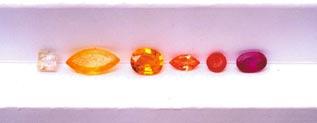
The SSEF GemLIBS system in the laboratory of the Swiss Gemmological Institute SSEF. The system consists of a sample chamber with attached laser (centre), the high resolution fibre optic spectrometers, the laser power supply (right), and a computer for system control (left).
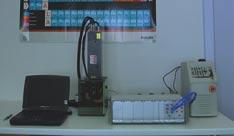
© H.A. Hänni, SSEF 2004
Results of gemstone testing with LIBS
First results on the specially designed SSEF Gem LIBS system have provided positive results to safely detect Be-diffusion treated sapphires. Beryllium could be detected in all the investigated diffusion treated samples (containing 3 - 50 ppm Be). Based on extensive testing, we were able to develop an analytical routine for serial testing of gemstones, especially for their Be content. Since June 2004, SSEF offers Be detection in sapphires as a reliable and affordable testing service for the gemstone trade.
The method: LIBS in the SSEF Laboratory
By the end of April 2004, SSEF Swiss Gemmologi cal Institute was the first gemmological laboratory having installed a LIBS instrument for gemstone testing. The instrument was specially designed for our purposes in cooperation with Ocean Optics. The SSEF GemLIBS system is based on a 1064nm NdYAG laser and a series of seven high-resolution fi bre optic spectrometers, which enable the recording of emission spectra in the range between 200 and 970 nm. A special sample holder enables precise targeting of the confocal laser beam to minimize any damage on the gemstone due to laser ablation. The gemstone is analysed on the girdle to minimize the visibility of the laser ablation (diameter of laser spot < 0.1 mm !).
The analytical procedure is characterized by: - easy sample preparation - minimal damage due to reduced laser beam energy - precise positioning of the laser beam on the sample - continuous emission spectrum (200-970 nm) - simultaneous detection of many different chemical elements
- limit of detection for Be below 3 ppm
- much cheaper and easier than LA ICPMS or SIMS analysis
In this study, LIBS has been used in gemmology for the first time. Apart from detection of Be diffusion treated sapphires, LIBS may have some potential for geographic origin determination of gemstones and detection of colour modification in pearls.
SSEF research Page 8 SSEF Facette No. 12, © 2005
Easy detection of Be-diffusion treated corundum with Laser Induced Breakdown Spectroscopy (LIBS)
Beryllium diffusion treated corundum. © H.A. Hänni, SSEF 2003
LIBS spectra of Be diffusion treated sap phires compared with natural untreated sap phires. The Be detec tion is based on the Be peak doublet centred at 313,1 nm.

© M.S. Krzemnicki, SSEF 2004
Acknowledgements:
The authors would like to thank Roy A. Walters, Kees Van De Steeg, and all the staff from Ocean Optics for their support during installation of LIBS at SSEF Swiss Gemmological Institute. Further thanks go to Mr. Hans-Ruedi Rüegg for technical assistance. LA ICPMS analyses for calibration were carried out at the Federal Technical Institute Zurich by Dr. Thomas Pettke from the lnstitute of Mineral Resources under the direction of Prof. Christoph Heinrich. For sample material we would like to thank Mr. Werner Spaltenstein and Djeva S.A. (Monthey, Switzerland), producer of synthetic stones.
Be
Be
analysis
Tiny
© H.A. Hänni, SSEF 2004
This summary is slightly modified from a poster presentation at the LIBS Conference in October 2004 in Malaga, Spain. A detailed article about the method is published in the Winter Issue of Gems&Gemology 2004. For further details please contact SSEF at gemlab@ssef.ch
Be-detection as a new service
For many years, SSEF is issuing so-called treat ment slips for clarity enhanced emeralds. Starting in June 2004, we now offer the same kind of treatment document for beryllium diffusion treated sapphires. You want to know if your stone is really a padpar adscha or not? You want to guarantee your client undiffused yellow sapphires? You want to maintain your integrity by not using Be-diffused stones in your jewellery? For all these requirements, we have now the right answer: LIBS. We test your stones with a new and reliable method at a very attractive rate (prices without VAT).
- one single stone CHF 150.- per stone in a lot (min. 5 stones) CHF 50.-
For more information, please contact SSEF at gemlab@ssef.ch or tel. +41-(0)61-262 06 40 or visit us at one of the Gem Fairs where we are present.
SSEF research Page 9SSEF Facette No. 12, © 2005 307 308 309 310 311 312 313 314 315 316 317 wavelength (nm)
diffusion treated not Be diffusion treated
peak 313,1 nm
SSEF
Swiss Gemmological Institute LIBS
LIBS laser spot on a yellow sapphire. The diameter of the spot is < 0,1 mm (< 100 µm).
Lead glass filled fractures in rubies

For years it has been known that heavily frac tured rubies can be enhanced by a heat treatment together with a flux. Commonly borax was used as a basis of the glassy melt that would enter the fissure system. Recrystallisation of the fissure surfaces involving the formation of small portions of synthetic corundum improves the stability of such stones. Temperatures around 1600 °C are applied, a temperature which usually removes all rutile silk. By that fact such a flux supported heat treatment is well recognisable. The newly structured so-called neo-healing fissures let the former plain fractures appear less visible and are most reminiscent often natural healed fissures or flux synthetic material. The stones treated by this way are at the same time heated (may improve colour and clarity) and contain a variable amount of foreign glassy substance, often called “residue”. The international related gem labs group (LMHC) have introduced a scale of terms to use on test reports (see Facette 11, January 2004, or LMHC Information Sheet 1, www.ssef.ch/ harmonization1.pdf ).
than on high temperature borax treatment. The high refractive index and dispersion of this lead glass are responsible for purplish blue flashes, which eas ily identify stones treated after this new procedure. Frequent gas bubbles are another typical feature of this treatment. The new substance in corundum fissures is not more difficult to identify than the forerunner substances. The lower temperature, however, does not allow the re-crystallisation of the fissure planes; the stability of the stone is thus not enhanced. The low treatment temperature will still enable a colour shift (oxidative heating destroys the blue colour component) and may produce a nicer red.
A new development in fracture filling has now appeared by a lead glass impregnation of fractured rubies. The lead glass has a lower melting point and a higher refractive index compared to the usual borate glass filling. We estimate that temperatures around 700 °C or lower are applied. We have thus a coexistence of glassy filling and rutile needles, other
Identification of the lead glass may be done by the observation of colour flashes, presence of a Pb signal with EDXRF, or bright structures on microradiographs. These characteristics and the presence of gas bubbles in the glass filling is reported by a number of colleagues from the leading gemmo logical laboratories in Japan, USA, Thailand a.s.o. Beginning of February 2005, LMHC will publish a press release on lead glass filled rubies (download at www.ssef.ch/harmonization3.pdf)
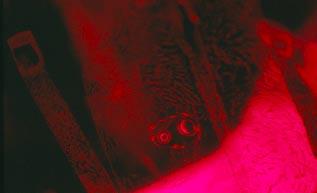
SSEF research Page 10 SSEF Facette No. 12, © 2005
Lead glass filled fractures in ruby. The bluish “flashes” and trapped airbubbles are characteristic features of this treatment. © GAAJ Japan, 2004
“Traditionally” heated ruby with glassy residues (and airbubbles) along healed fissures. © H.A. Hänni, SSEF 2005
Chinese cultured pearls
During the International Gemmological Conference IGC in September 2004, Prof. Hänni gained new and first-hand information about Chinese cultured pearls. China produces both, beaded saltwater cultured pearls and beadless freshwater cultured pearls. The beadless cultured pearls are by far the most important product with approx. 700 tons of pearls per year. It is amazing to see how these cul tured pearls developed from the small „grain of rice“ shaped pearls into round, beadless cultured pearls of up to 14 mm diameter nowadays. The pearls which are produced come in white and pastelhues, commonly natural colours, and in all sorts of shapes. For the large pearls, the duration of cultiva tion is up to 7 years. The mantle tissue to start the pearl growth originates from very young mussels (Hyriopsis cumingii). Up to 30 tissues are implanted in three rows in each half of the bivalve mussels. This is carried out by young chinese female work ers. The mussels are then kept in shallow, rectangular ponds (e.g. 200 x 500 m), which replace former rice fields.
Publications 2004
In 2004 the SSEF has published numerous articles in scientific and trade journals:
Publications on pearls: Cultured pearls from the Gulf of Mexico (Kiefert et al., Gems & Gemology, Vol. 40, 26-38), pearls from the lion’s paw scallop (Scarrat & Hänni, J. Gemm., Vol. 29, No. 4, 193203), and Pearl imitations (Hänni & Chalain, Revue de gemmologie A.F.G., Vol. 150, 20).
Publications on diamond: Green diamonds of natu ral coloration (Chalain et al., Paper presented at the 55th Diamond Conference, Warwick, UK), hydro gen-rich floral diamonds (Rondeau et al., Diamond and Related Materials 13, Issue 9, 1658-1673), synthetic CVD diamonds (Deljanin et al., Diamond Conference 2004, Warwick, UK), and the possibili ties of Jewellers to detect treated diamonds (Hänni, Conference: Le Diamant – Rêve et Réalité, Paris, pages 52-53).
Publications on corundum: SSEF was the first laboratory having published several articles on laser induced breakdown spectroscopy (LIBS) for detec tion of beryllium diffusion treated corundum (Hänni et al., 29th International Gemmological Conference, China University of Geoscience, Wuhan), page 63; Hänni & Krzemnicki, J. Gemm. Assoc. of Hong Kong, Vol. 25, 93-95; Krzemnicki & Hänni, 3rd International Conference on LIBS and Applications, Torremolinos (Malaga), Abstract P 62. The most complete description is given in: Krzemnicki et al., Gems & Gemology, Vol. 40, No. 4, pages 314-322.
Furthermore, SSEF published on red and green labradorite (Krzemnicki, J. Gemm., Vol. 29, No. 1, pages 15-23), asterism in beryl (Schmetzer et al., J. Gemm., Vol. 29, pages 65-71), pezzottaite (Hänni & Krzemnicki, J. Gemm., Vol. 29, pages 75-76), Verneuil corundum with unusual colour zoning (Kiefert et al., Gems & Gemology, Vol. 40, No. 4, 354-355), black coated horn coral (Hänni, Gems & Gemology, Vol. 40, No. 1, 78-79; Hänni & Chalain, Revue de gemmologie A.F.G., Vol. 150, 21) and dyed horn as imitation of amber (Hänni, Gems & Gemology, Vol. 40, No. 3, 265-266).
Opened mussel with beadless cultured freshwater pearls in the mantle (Donggou, near Wuhan).

© H.A. Hänni, 2004
All publications can be ordered as a reprint or fotocopy at SSEF. Please send an e-mail to SSEF (gemlab@ssef.ch), indicating the title of publication you would like to receive, or contact us by phone +41-(0)61 262 06 40.
SSEF research Page 11SSEF Facette No. 12, © 2005
Scientific Course and Special Courses
Participants of the Scientific Gemmology Course get a close insight into scientific methods for gemstone testing. The following participants received an SSEF Scientific Gemmologist Certificate in 2004:

Mr. Yehuda, IGC, Ramat-Gan, Israel
Mr. Shoohack Shon, Seoul, South Korea
Dr. Nabila Salama, Loola Lapidary Laboratory, NY
Peter Groenenboom, AEL Arnhem, Netherlands
Congratulations to new SSEF Basic Gemmologists
As in previous years, our basic gemmological for mation is well appreciated by many people from the trade as a first step to gain insight into the field of coloured stones, diamonds and pearls. Only candidates who have fulfilled SSEF standards of gemmo logical knowledge and practical testing during a final examination receive the SSEF Basic Gemmologist Certificate.
We would like to congratulate the following partici pants for their SSEF Gemmologist Certificate in 2004:
Basic Gemmologist Certificate:
passed with distinction:
Mrs Inna Lagnaux, Zurich, Switzerland
Mr Daniel Cattai, Rickenbach bei Wil, Switzerland
Mrs Annette Halef, Siebnen, Switzerland
Mr Marcel Hausheer, Zurich, Switzerland
Mr Emanuel-Jakob Kuhn, Pfaffhausen, Switzerland
Mrs Erika Menamkat, Rolle, Switzerland
Mr Sebastian Müller, Zurich, Switzerland
Mr Jean-Marc Rentsch, Zurich, Switzerland
Dr. Thierry Salva, Saint-Louis, France
Mr Stefan Zahner, Zurich, Switzerland
The following participants received the Advanced Gemmologist Certificate after participating at SSEF courses:
Mr Georges Amer, Chanel, Paris
Mr Alfio Dopudi, Milano
Mr Wolfgang Ehrbar, Patek Phillippe, Geneva
Mr Adrian S. Grond, Century Time Gems Ltd, Switzerland
Mr Gilbert Torres, Blue Peacock, Zurich
Mrs Laura Wohland, Tiffany & Co., New Jersey
Additionally, Dr. Krzemnicki was travelling around the globe to give special instrumental training courses in the Middle-East and in the States. As we have seen, this service is especially requested by former students of the SSEF Scientific Gemmology Courses at SSEF laboratory, which require an in-house training in their own laboratory, based on the experiences they already got during their stay at SSEF in Basel.
With our knowledge on the detection of beryllium diffusion treated sapphires with LIBS, we offer now similar LIBS training workshops for other labora tories abroad. For further information about SSEF Scientific Gemmology Courses and SSEF Special Courses, please contact gemlab@ssef.ch
Mrs Lori Duncan, Tiffany & Co., New Jersey
Mr Matthew Buccieri, Tiffany & Co., New York
Dr. Nabila Salama, Loola Lapidary Laboratory, NY
Special Courses were held for:
Nick Sturman, Gem & Pearl Testing Laboratory
Bahrain Gulf Scientific Corporation, Dubai
Louis Vuitton, La Chaux-de-Fonds, Switzerland
Artecad, La-Chaux-de-Fonds, Switzerland
Chatelain, La-Chaux-de-Fonds, Switzerland
Vögeli & Wirz, Biel, Switzerland
Tiffany & Co., Parsippany, New Jersey
Christie’s, Geneva
SSEF Courses Page 12 SSEF Facette No. 12, © 2005
From left to right: Yacar Yehuda, Peter Groenenboom, Shoohack Shon, Prof. Hänni and Dr. Nabila Salama
New: Launching of the SSEF Alumni
Since 2001, many students from all over the world have followed gemmological courses at the SSEF. More and more, we got the feeling that many participants would like to keep in touch with both, new developments in gemmology and former col leagues of their courses. We are therefore proud to announce that from this year on, former course par ticipants have the possibility to become member of SSEF Alumni to share a platform of networking and information. As a member of SSEF Alumni you may share and gain information on the SSEF Alumni homepage and newsletter. You may also promote your own business on this platform, as long as it is in accordance with our Alumni regulations on integ rity. Furtheron, SSEF Alumni will plan and organise gemmological field trips for their members.
The foundation of the SSEF Alumni is on Sunday evening, May 1, 2005, during the GemmoBasel Colloquium (Please see attached GemmoBasel 2005 programme). All former course students are kindly invited to participate at the first SSEF Alumni dinner. At that moment, we will present you also the chairman of SSEF Alumni, Mr. Leon Ascot, and Mr. Peter Groenenboom (ambassador of SSEF Alumni), who both have taken over their function with great enthusiasm and energy.
In the next few weeks, we will inform all course participants personally about the location and exact schedule of the first SSEF Alumni dinner. But you may also contact SSEF directly to get all informa tion (by phone +41 (0)61 262 06 40 or e-mail: gemlab@ssef.ch). We hope, this evening will be an inspiring event for all participants.
A good example: Vögeli & Wirz
For several years we are offering special courses for the quality grading of small diamonds (diameter > 1 mm). These courses (SSEF Advanced Training 5a) are well appreciated by the watch industry. They are using large quantities of small diamonds which have to be tested to maintain the quality criteria of their respective company. But also the suppliers of the watch industry are participating in such courses. Naturally, the testing of such small diamonds is different to the grading of a 1 ct diamond.
The philosophy of testing has to be adapted, as the instrumental routine, which is used. To support our courses on small diamonds, Mr. Adrian Veraguth from Vögeli & Wirz in Biel (Switzerland) has do nated a new special microscope (Sortoscope® from Nossigem, Germany). We would like to thank him for this kind donation.
A Refractometer with best scores
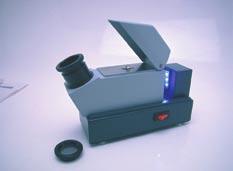
The most important gemmological instrument besides the 10x magnification is the refractometer. Over the years we have seen quite a number of dif ferent refractometers: old refractometers with blind glass hemicylinder, expensive refractometers where you have no money left for the contact liquid, cheap refractometes out of plastic which melt away with acetone, impressive refractometers which look at you with an enormous eye. Now we have found an excellent refractometer for a fair price, nice make up and really excellent precision. The producer also offers a power packed light source base with LED light. We were so impressed that we instantly bought 10 pieces for SSEF students and other in terested clients. You may still have a chance to get one for SFr. 800.- (gemlab@ssef.ch or +41 (0)61 262 0640)
Refraction Index
Theoretical Measured Precision
1.503 0.04%
1.533 -0.01%
1.560 -0.04%
1.590 0.03%
1.614 -0.02%
1.621 0.02%
1.754 0.03%
SSEF news Page 13SSEF Facette No. 12, © 2005
1.5036
1.5329
1.5594
1.5905
1.6137
1.6214
1.7545
How to ship your stones to SSEF? - No problem!
For more than a year, we offer a service, which has gained much appreciation by our clients. You may send your unmounted stones or pearls to our agency in Germany, which cares for all custom formalities:
Step-by step:
1. You need an insurance for the shipment
2. Include a pro-forma invoice to the shipment, indi cating the value of the items and the reason for shipping (e.g. certification of items)
3. A copy of this pro-forma invoice has to be sent to SSEF by fax +41 (0)61 262 06 41
4. Include the SSEF order form or a note in which you declare what kind of test/certificate you require
5. Then send your parcel to our agency in Germany:
SSEF c/o Erwin Morlock Friedrichstrasse 26 D-79618 Rheinfelden, Germany
For each direction, you may count with 3-4 working days for the shipping with mail service. Depending on our arrangement, we will need between 1 and 7 days for testing in the SSEF laboratory.
The costs for the complete importation/exportation formalities are:
1. Customs formalities and shipment back to you CHF 110.-
2. If you need no insurance for the shipment back to you, ca. CHF 30.- to 150.depending on the value of the items
For sure, you may still ship your items to the SSEF directly, as listed in our shipping instructions. For more informations, please call SSEF (+41 – (0)61 262 06 40) or visit us at our booth at the Basel Fair or at the Gem Fair in HongKong in September 2005.
Lore goes to AGTA
At the end of January 2005, Dr. Lore Kiefert, who has been with SSEF for many years now, will leave our laboratory to take over a leading position at the AGTA Laboratory (American Gem Trade Associa tion) in New York. At present, Dr. Kiefert is director of the Coloured Stone Department and deputy
director of the SSEF laboratory. She contributed considerably in building up SSEF in Basel and proved to be a very reliable colleague in all areas of the business. Now Dr. Kiefert does not want to miss the chance to help lead another young laboratory to success. At the moment she is using the rest of her time in Basel to train her successor Dr. Sophie Wolf, who will be introduced later. At this place, we would like to thank Lore for her 10 years of energetic co operation, her friendliness and social competence. In the future we can count on a congenial partner in New York.
Beware of fraud on holidays!
A well appreciated service of SSEF is the verbal Short Testing routine. Stones are identified and the result is communicated verbally. This inexpensive service (CHF 30.- per stone) is used by clients who send the stones as well as by clients who come to the counter and wait for the result. Lately, we have encountered frightening pieces from tourists who have spent their vacations in Turkey. Quite often we have seen synthetic and diffusion treated sap phires, decently mounted with diamonds. And the clients have paid impressive amounts of money (CHF 50’000.-), money they would never spend at home. The same situation occurred with a black pearl necklace, bought as Tahitian cultured pearls in a Turkish Mediterrean metropole. The strand was of dyed Chinese freshwater pearls. The amount paid was CHF 8’000.-
CIBJO News
The last CIBJO congress was organized in Bangkok, March 2004. New statutes were accepted by the CIBJO Executive Committee and therefore are valid now.
CIBJO stands now for World Jewellery Confederation and embraces:
Sector 1: Jewellery Manufacturing/Technology/ Precious Metals
Sector 2: Jewellery Distribution Sector 3: Gem Materials, Trade and Laboratories
Several new commissions were formed: - Presidential Council - Ethics Commission - Marketing Strategy Commission - World Jewellers Vigilance Committee - Sterling Silver Commission
SSEF news Page 14 SSEF Facette No. 12, © 2005
A public relations office was appointed during the Basel Fair to distribtribute regularly CIBJO press re leases. Driven by the energy of its President, Dr. G. Cavallieri, CIBJO is definitely facing new challenges in the gem industry.
News from LMHC
The Laboratory Manual Harmonization Committee (LMHC) is a group of seven international gemmo logical laboratories appointed to propose a harmo nized wording and nomenclature usable by gemmo logical laboratories.
The seven laboratories are:
- AGTA Gemological Testing Center, USA
- CISGEM, Italy
- GIA Gem Trade Laboratory, USA
- Gemmological Institute of Thailand, - Gemmological Association of All Japan, - Gübelin Gem Lab, Switzerland
- SSEF Swiss Gemmological Institute, Switzerland
Since our last Facette, the comittee met in Bang kok, in Lucerne and in Basel. So far, the LMHC main achievements are summarized in two pub lished documents which can be downloaded at www.ssef.ch/harmonization1.pdf (InfoSheet 1: Corundum with residue from the heating process ...) and www.ssef.ch/harmonization2.pdf (InfoSheet 2: Corundum with colour induced by lattice diffusion). Recommendations of both documents should be implemented since February 2004. A third InfoSheet is being prepared. It deals with the lead glass filled enhancement mostly seen in corundum. It will be presented at the next Tucson Fair (February 2005) and afterwards you may download it at www.ssef.ch/harmonization3.pdf
Obituary: Philippe Maitrallet
On Sunday, 19 December, Philippe Maitrallet, direc tor of the French gemmological laboratory (CCIP) died in Paris following a heart attack. His fragile health was heavily degraded by accusations questioning his professional credibility in an unjustified way. After six years of trial, Philippe Maitrallet was proven innocent on request of the prosecutor, who finally listened to reason thanks to the witnessing professionals.
Be it his students, be it his clients, all who had the pleasure of knowing Philippe Maitrallet will remem ber him as an excellent example of honesty, kind ness and discretion.
Donations in 2004
We gratefully thank the following donators
Christie’s S.A. (Geneva), which enabled us to hold lectures for their clients during the spring auctions in Geneva
J.-S. S. DeYoung Inc. (New York), for their generous donation and support Charles Abouchar (Geneva), for three rubies treated with lead glass
Werner Spaltenstein (Chantaburi, Thailand) , for purple crystals of spinel and spinel-bearing marble from Tanzania
Suvilai Wachiruksasawakul (Bangkok), for eudyalite cabochons from Russia
Djeva SA. (Monthey, Switzerland), for one lot of taylored synthetic corundum
The Silurian Co. (Surrey, Great Britain), for rough corundum from Malawi
Dr. Nabila Salama (New York), for a yellow synthetic diamond
Mr. Wu (Taiwan), for coated pink topaz
Roland Uhl (Winterthur, Switzerland), for a yellow synthetic sapphire
Hildy Rost (Zurich), for an emerald crystal
Daniel Cattai (Rickenbach, Switzerland), for one faceted smoky quartz
Jörg Hänni (Basel), for four damaged diamonds and one peridot crystal
Inna Lagnaux (Zurich), for charoite and malachite from Russia
Leon Ascot (Rüschlikon, Switzerland), for purple sapphire from Kashmir
Hanna Frey (Lenzburg, Switzerland), for ‘Bohnerz’ from the Jura mountains
Thomas Frieden (Thun, Switzerland), for Kasumi gaura and Japanese Keshi cultured pearls
Thomas Färber (Geneva), for small natural pearls
Peter Groenenboom (Arnhem, Netherlands), for various imitations of organic gem materials and Agtreated pearls.
Wilhelm Schoeffel GmbH (Stuttgart, Germany) for numerous cultured feshwater pearls, loose and strung on strands
Adrian Veraguth of Vögeli & Wirz (Biel, Switzer land), for a donation for a special microscope for small diamonds
Dr. Hans-E. Sattler (Bonn, Germany), for a portable sortoscope by Nossigem®
SSEF news Page 15SSEF Facette No. 12, © 2005
IGC 2004 in Wuhan (China)

Usually, the International Gemmological Conference takes place every two years in one of the mem bers’ countries. Postponed for one year because of SARS, the latest conference took place in Septem ber 2004 in Wuhan, a large city with a university for Geosciences. A pre-conference tour covered Shanghai diamond bourse, cultured pearl farms and a turquoise mine. The conference was attended by a significantly smaller number of participants than usual. Nevertheless, the talks were covering many different aspects of gemmology on a high scien tific level. The current gemmological research was further enlightened by a poster session. Delegates and guests had the chance to discuss in depth, or enjoy the marvellous Chinese dishes at night. The organisers, among them Prof. Yuan Xinqiang and Prof. Mimi Ou Yang, did a great job and organised an excellent conference with their staff. A postconference tour embraced a trip to a diamond and to a peridot mine. At the conference some of the Swiss delegates present were G.Bosshart and Prof. H.A.Hänni.
SSEF Swiss Gemmological Institute and professor for gemmology at the University of Basel. The character of GemmoBasel2005 is that of a festive colloquium at the Basel University and is organised by Dr. Lore Kiefert together with the SSEF Team. The conference is open for everybody interested in gem mology. Its aim is to bring together a broad audience with internationally outstanding gemmologists, mineralogists, and members of the trade. Short talks will give a picture about gemmological devel opments, and participants will have the opportunity to exchange information with the speakers. It is a pleasure that so many top gemmologists from all over the world, producers of synthetic gemstones, pearl experts, auction houses etc. have agreed to participate. Among the famous names that you will be able to meet are: John Koivula, Richard Hughes, Dr. Paul Spear (DTC), Prof. Emmanuel Fritsch, Dr. Karl Schmetzer, Dr. Ulrich Henn, Antoinette Matlins, Alice Keller, Prof. Gaston Giuliani, Elisabeth Strack, Ken Scarratt, Prof. Vladimir Balitsky, François Curiel (Christie’s), Werner Spaltenstein, and many more. You can find the complete programme on the conference website www.gemmobasel2005.org. The event is sponsored by various companies and privates who would like contribute in their way for a great sucess. Registration (deadline: 15 March) preferably directly on the conference website www.gemmobasel2005.org (or at SSEF gemlab@ssef.ch , tel. +41 (0)61 262 0640)
Meet us in 2005 for On-Site Certificates
In 2005, we will be present at the following Gem Fairs:
Tokyo Fair 25 - 30 January 05
Inhorgenta Munich 25 - 28 February 05
Basel World 2005 31 March - 7 April 05
De la Paix Show, Geneva 15 - 20 May 05
Hongkong Gem Fair 17 - 21 September 05
GemmoBasel 2005
In Switzerland you can find two of the best known gemmological laboratories of the world (SSEF and Gubelin). Both laboratories serve the most impor tant auction houses and gemstone companies as well as the trade and privates. Much further than Geneva and Basel, their services reach the whole world. Therefore it is not surprising that an interna tional gemmological conference, which brings to gether international gemmologists with members of the trade should take place in Switzerland. The for mal cause for this conference is Prof. Dr. Henry A. Hänni’s 60th birthday. Prof. Hänni is director of the
De la Paix Show, Geneva 13 - 17 November 05
SSEF at new location at the Basel Fair 2005: Use our 24h Express Service
As in previous years, SSEF is offering again a 24h Express testing service during the Basel Fair (31
SSEF Showtime Page 16 SSEF Facette No. 12, © 2005
Two smart Swiss Guys at the IGC
March to 7 April 2005). As in previous years, the organisers have implemented major changes in the structure of the show. During this process, we now have a new location. This year you will find us in Hall 3.1 (first floor), at booth N05 (tel. at the booth: +41-(0)61 699 51 29. We hope to meet you during the Fair for a small conversation, sharing some information and for testing your stones.
Update yourself with new SSEF newsletter
During one year, many things may happen in the gem trade. We feel that apart from the annual SSEF Facette, we would like to keep you informed on the “hottest” news which we come through. May it be a new testing service, a special course an nouncement or a gem trade alert. Therefore we will start an electronic newsletter, which will be sent out to you by email about every three months. We would appreciate if you could send us an email to gemlab@ssef.ch for subscription.
SSEF around the world
In 2004, SSEF was again hopping around the globe. In January 2004, Prof. H.A. Hänni was at the Tucson Fair in Arizona (USA), during which he was honoured by the Bonanno Award. Afterwards he met Dr. Lore Kiefert and Dr. Michael S. Krzemnicki in New York, where they met a lot of SSEF cus tomers. Dr. Krzemnicki took the opportunity to visit Ocean Optics Ltd in Orlando (Florida), to further test the LIBS system. In February 2004, Dr. Kiefert and Prof. Hänni were present at the Inhorgenta Fair in Munich (Germany) at the joint booth of CIBJO, the German Gemdealers Organisation and SSEF. Later, Prof. Hänni was invited as guest-speaker at the meeting of the Gem-A Midland Branch in Birmingham (UK). In March 2004, Jean-Pierre Chalain travelled to Bangkok for the meetings of CIBJO and LMHC. In April 2004, Dr. Kiefert gave a talk at the GIA London. Shortly afterwards, J.-P. Chalain participated at a further meeting of LMHC in Lucerne (Switzerland). In May 2004, Prof. Hänni and Dr. Krzemnicki were invited as speakers at the annual reunion of the Swiss Gemmological Society (SGG) in Yverdon. Afterwards, SSEF was again present at the spring auctions in Geneva. In June 2004, Prof. Hänni was in Paris and gave a lecture about diamonds for the Belgian-French Chambre de Commerce. In the same month, Dr. Kiefert participated at the international Georaman Conference in Hawaii, where she presented recent research projects. In July 2004, J.-P. Chalain gave a talk at
the international Diamond Conference in Warwick (UK). In the same month, Dr. Krzemnicki visited Dubai for a specific laboratory course. In September, Prof. Hänni travelled to Wuhan (China) to participate at the 29th International Gemmological Conference (IGC). Afterwards he went to Hong Kong for the Jewellery Gem Fair and joined Dr. Kiefert and Petra Niggli at the SSEF booth before continuing his travels to Bangkok for lectures at the university and for contacts with the trade. End of September, Dr. Krzemnicki was in Malaga (Spain) to present first results with the SSEF GemLIBS at the 3rd International Conference on LIBS. In October 2004, Dr. Kiefert gave a talk on gemstone treatments in Leiden, Netherlands. Shortly after wards, she and Prof. Hänni were in Königstein near Frankfurt (Germany) holding a course for a number of German jewellers. In November 2004, the SSEF team was again at the De la Paix Show and the autumn auctions in Geneva. In December, Dr. Krzemnicki went to New Jersey (USA) for a special course at Tiffany & Co. Finally, Prof. Hänni was invited as a gemstone expert for an interview on Swiss television.
Close Up: Prof. Henry A. Hänni
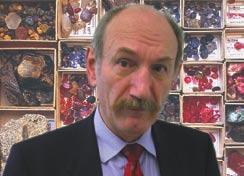
In these days Prof. Hänni will celebrate his 60th an niversary, a good reason to devote this Close up to him. Since 24 years he has been a PPG (passion ate professional gemmologist) and gemstone re search mineralogist. He likes colour and symmetry and therefore is well placed in the gem industry. For
years he also likes to travel and has visited an impressive number of gemstone deposits world wide. Being an adventurous diver, he is get ting first hand information from the sea floor, too, and his special interest there goes to pearl forming shells and snails. With his obligation to teach gemmology at Basel University he is always with young people, a fact that may have supported to stay his mind young. As boss of the SSEF institute he sometimes surprises his colleagues with a strong sense of humor...
SSEF Showtime Page 17SSEF Facette No. 12, © 2005
The SSEF Team wishes all friends and customers a successful New Year 2005 and would like to thank you kindly for your continuous support of the SSEF laboratory.
SSEF Diamond Spotter inspires HRD
Expensive advertisements published in trade jour nals announce that HRD now sells a new device: the “D-Screen”. As big as a refractometer, this an nouncement sounds exciting: “Distinguishes Natural from Treated or Synthetic Diamonds”. Further explanations decline this announcement since in fact the working process of this new instru ment is exactly the same as that of the famous SSEF Diamond Spotter. Far from being capable of distinguishing natural from treated diamonds, both devices indicate only whether the tested diamond is transparent to short-wave UV light or not. If it is transparent to short-wave UV , the stone should be sent to a gemmological laboratory for further testing. To protect the trade from the arrival of possible HPHT treated diamonds, SSEF is selling SSEF Diamond Spotters since 2000. Its price is $ 100.-. Since the beginning of 2005, HRD proposes its own variation of the SSEF spotter for the price of 2475.Euro !
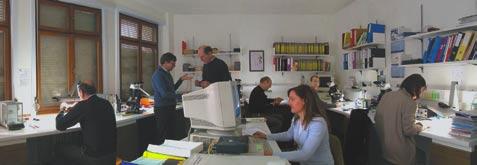
Last page Seite 18 SSEF Facette No. 12, © 2005



















